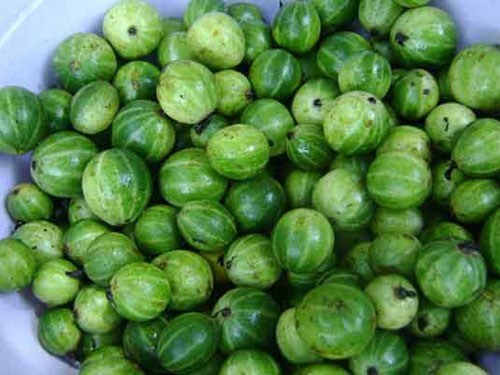Making this dish isn’t difficult. You only need a few ripe tomato, they are normally a beautiful yellow color and should still be crunchy. These are cut into small pieces. Take one wild tomato, a piece of lemon, some coriander, green chili and grind it to a paste with a mortar and pestle. This bitter tomato dish can be served with either hot or cold steamed rice. The dish was created by a clever combination of spicy and sour tastes. Highland cuisine never lacks the crunchy taste of tomato and the spicy flavor of tiny chili.

Bitter tomato
Only farm grown tomatoes, planted along a fence or growing wild at the edge of the jungle will be bitter. They are round in shape and slightly larger than white tomato. They are seedless and have thorns where the fruit joins the branch. Bitter tomato plants bear fruit throughout the year and therefore this crushed bitter tomato dish can be served at any time of the year. According to the experience of the Jrai people, eating this dish helps to prevent rheumatism, arthritis and osteoarthritis. Strangely, if the same tomato plant is grown in the garden, the fruit will be bigger and loses its bitterness.
The bitter tomato can be eaten either ripe or unripe; each has its own unique taste. Ethnic minority people also use it as a salad. They can be cooked with other ingredients such as stir-fried with frogs, in a fish soup, with dried fish, or stewed with river shrimp. There are two spices which are never omitted when preparing ripe bitter tomato, chili and chopped piper-lolot leaves.
One of the bitter tomato dishes made that one can never forget is that made with cassava leaves. In the gardens of Jrai people there is always a cassava tree. The type of Cassava that provides the edible leaves is the variety with the small trunk. The leaves are picked when very young, then they are just right to make this dish.
The cassava tree will continue to produce new leaves as they are picked. Cooking bitter tomato with cassava leaves is quite a simple process: wash and drain the young leaves before grinding or crushing by hand. The bitter tomato is cut in half and added along with chili and crushed.
This dish could be made using a little meat. The meat is seasoned and stir-fried in advance. Later it is mixed with bitter the tomato, green chili and cassava leaves. This dish is served with steamed rice and the taste is improved if it is a little fatty and bitter.
If you want to try the bitter tomato and cassava leaves dish, pay a visit to Choet village and the Bazan restaurant own by husband and wife, Ksor H’Oanh. It is situated at 478 Le Duan, Thang Loi. Alternatively you can go to the Green Pleiku restaurant in Plei Op village close to Pleiku city. The true version is only the one made by the local ethnic minority people.

Cassava leaves
The soil in Krongpa is dry and not suited
to coffee, rubber or pepper like other highland areas. It is however suited to
cassava especially with the local climate. The bitter tomato and cassava leaf
dish in this area is certainly the best.
In 2014, I went to Krongpa early in the
rainy season with my friends.Ha Viet Trinh, who works in the people’s court
made this dish for me. A simple mixture of ground cassava leaves, bitter
tomato, green chili and a little bit of venison for the soup. The combination of tastes between bitter,
sweet and spicy has always stayed with me.
I also came back to Pleiku several times
and tried this dish again, I don’t know why but I feel like it lacked the
flavor of highland region version. I got in the car and travelled a hundred
kilometers to Krongpa and told my friend that “Please make a dish of bitter tomato
and cassava leaf” My friend smiled and pointed in the direction of the distant
mountains. You see, if there are no mountains and forest then it isn’t the
highlands.
Local ethnic minority people should be left
to live in their own jungles and villages so they can keep their traditional
way of life. So it is with bitter tomato, leave it to grow in the wild or along
farm fences and don’t cultivate them like other tomato or it may lose its
bitterness.
Ask yourself “What should we eat to
remember the highland region?” because as soon as you leave the highlands you
will miss it. Remember the mystery of jungle, the power and grandeur of the
bubbling waterfalls and the endless wild beauty of the mountains. Memory will
be stronger when the taste of “Rượu cần”-
a big bottle of rice wine is enjoyed. It
will be served to big groups of people with bamboo straws, so maintaining the
nostalgic jungle atmosphere.
FollowedV.H
Dan Tri Newspaper
Extracted
from articles written especially for the Golden Spoon 2014 called “A journey of
searching traditional rustic dishes for the cuisine of three regions”